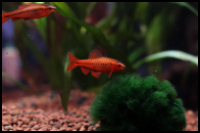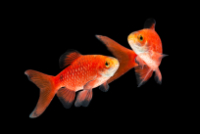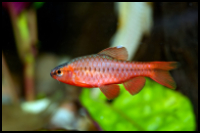





Quick Care Details (Table)
| Livestock Characteristics | Value |
|---|---|
| Care Level | Easy |
| Temperament | Semi-Aggressive |
| Diet | Omnivore |
| Maximum Size | 3 Inches |
| Minimum Tank Size | 20 Gallons |
| Plant Safe | Yes |
| Temperature Range | 74-79F |
| PH Range | 6.0-7.0 |
| KH Range | 4-10 |
Species Specific Categories
Helpful Video
Care Details
Aquascape: Cherry Barbs thrive in aquariums that replicate their natural habitat. Consider densely planting the tank with live plants, especially around the perimeter, to provide hiding spots. Driftwood and rock formations can also enhance their environment. Ensure open swimming areas in the middle to mimic their native open waters.
Substrate: A fine gravel or sand substrate is ideal. Cherry Barbs may sift through the substrate in search of food, so a smooth surface is best to prevent injury.
Disease Prevention: Maintaining a clean and stable environment is key. Regular water changes, proper filtration, and quarantine for new additions can help prevent disease. Stress reduction through suitable tank mates and a well-balanced diet is also crucial.
Filtration: A good quality filter with gentle water flow is suitable. Cherry Barbs are not strong swimmers, so excessive water movement can stress them. Ensure the filter doesn't create strong currents.
Lighting: Moderate lighting is sufficient. Live plants will benefit from a light source tailored to their needs, but it's not a primary concern for the fish themselves.
Water Flow: As mentioned earlier, gentle water flow is preferred. Cherry Barbs come from slow-moving waters, so strong currents can stress them.
Hardiness: Cherry Barbs are relatively hardy, making them suitable for beginners. However, they still require proper care and maintenance.
Acclimation: When introducing Cherry Barbs to a new tank, acclimate them slowly to prevent shock. Floating the bag in the tank and gradually adding tank water is a common acclimation method.
Expected Lifespan: With proper care, Cherry Barbs can live for 4 to 6 years, or even longer in some cases.
Special Requirements: Maintain a peaceful community of fish as tank mates. Cherry Barbs can be fin nippers, so avoid keeping them with long-finned or slow-moving species. Provide a balanced diet with high-quality flake foods, live or frozen foods, and occasional vegetables. They appreciate a well-planted tank for cover and will display their vibrant colors when comfortable.
Temperament and Behavior
Behavior: Cherry Barbs are like the lively little adventurers of the aquarium world. They're known for their peaceful nature, and their vibrant colors truly shine when they're in a comfy environment. These social fish thrive when they're part of a small gang in your tank.
Breeding: If you're looking to encourage some Cherry Barb romance, it's not too tricky. Create the right mood in your tank with plenty of plants or spawning mops. The females will sprinkle their eggs among the plants, and the males will come along to fertilize them. To keep the little ones safe, it's a good idea to relocate the adults after this romantic escapade. That's because Cherry Barbs may just consider those eggs a tasty snack. When the baby Cherry Barbs arrive, they can be nurtured on finely crushed flake food or infusoria.
Aggression: When the love bug hits, especially during the breeding season, the males might get a little territorial. It's like they're staking a claim to impress the females. It's not too serious, but to ease the tension, make sure there are enough nooks and crannies to hide in.
Tankmates Compatibility: Cherry Barbs are the life of the party in a community tank. They're chill with other peaceful pals like tetras, rasboras, and gouramis. Just steer clear of any roommates with a habit of nipping fins or causing trouble.
Activity Level: You'll find Cherry Barbs to be quite the active bunch. They love to explore their watery world, and they'll really appreciate a setup with lots of hiding spots and lush plants to frolic in.
Schooling or Shoaling Behavior: These fish thrive in the company of their own kind. So, aim for a gang of at least six Cherry Barbs to keep them feeling secure and sociable. In smaller groups, they might get a little shy and less colorful.
Plant Compatibility: Think of live plants as the cozy decor in your Cherry Barb's home. They won't nibble on your greenery, and having some lush plants around actually makes them feel more at home. Plus, plants help keep the water quality in check, so it's a win-win.
Diet and Nutrition
Dry Foods: Cherry Barbs are pretty flexible when it comes to their diet. They'll happily munch on high-quality flake and pellet foods, which are readily available at your local pet store. These foods are formulated to provide all the essential nutrients they need.
Frozen Foods: If you want to give your Cherry Barbs a treat, consider offering them some frozen foods like bloodworms or daphnia. These are like a gourmet meal for your fish and can be a tasty change from their usual dry diet.
Live Foods: In the wild, Cherry Barbs are known to nibble on tiny insects and larvae. You can mimic this natural diet by occasionally feeding them live foods like brine shrimp or mosquito larvae. Just be sure the live foods are from a trusted source to avoid any risk of disease.
Vegetables: While Cherry Barbs are primarily carnivorous, they may also nibble on some vegetable matter. Try offering blanched vegetables like spinach or zucchini. Some aquarists have reported success with this, but it's not a dietary staple for them.
Algae: Cherry Barbs won't be your go-to algae cleaners. To keep your tank pristine, it's best to rely on other algae-eating species.
Feeding Schedule: A regular feeding schedule works well for Cherry Barbs. Offer small amounts of food two to three times a day. This simulates their natural grazing behavior and ensures they get enough nutrition without overfeeding, which can lead to water quality issues.
Supplemental Foods: Occasionally, you can supplement their diet with treats like freeze-dried or live foods to add variety and keep them happy. Just remember not to overdo it – moderation is key in maintaining their health.
Tank Parameters
Tank Size: Cherry Barbs are small fish, so they don't need an enormous tank. A 20 to 30-gallon aquarium should suffice for a small group of them. However, if you plan to keep a larger school or add other fish, you may want a larger tank.
Tank Length and Measurements: When choosing a tank, consider one that is long rather than tall. Cherry Barbs are more active in the horizontal swimming space, so a longer tank provides them with more room to roam.
Water Temperature: Cherry Barbs thrive in a tropical environment. Keep the water temperature between 73°F and 81°F (22°C to 27°C). This range mirrors their natural habitat in the warm waters of Sri Lanka.
pH (Acidity/Alkalinity): These fish aren't too demanding when it comes to pH levels. Aim for a slightly acidic to neutral pH range of 6.0 to 7.0, which closely resembles their native waters.
KH (Carbonate Hardness): Cherry Barbs can adapt to varying carbonate hardness levels, but a KH between 2 and 8 dKH should work well.
GH (General Hardness): For general hardness, maintain a range of 4 to 12 dGH. This range ensures the water isn't too soft, which can be detrimental to their health.
Hardiness: Cherry Barbs are generally hardy fish, which makes them a great choice for aquarists of all experience levels. They can tolerate a range of water conditions as long as you maintain good water quality.
Nitrate (NO3) Levels: It's crucial to keep nitrate levels low in your tank, preferably below 20 ppm (parts per million). Regular water changes and good filtration will help maintain low nitrate levels, ensuring the well-being of your Cherry Barbs.
History, Popularity, History and Species Variety Details
The History, Popularity and Natural Habitat
History: The Cherry Barb, scientifically known as Puntius titteya, is a charming and vibrant fish species originating from Sri Lanka, a tropical paradise. These small, colorful barbs have gained popularity in the aquarium hobby due to their stunning appearance and peaceful nature. They were first described in 1999 and quickly became a favorite among freshwater aquarium enthusiasts.
Popularity: Cherry Barbs are highly sought after by aquarists of all experience levels. Their striking colors and peaceful temperament make them an excellent choice for community tanks. Novice and seasoned hobbyists alike appreciate their resilience and adaptability to various water conditions.
Natural Habitat: In their native Sri Lanka, Cherry Barbs inhabit slow-moving, clear streams, rivers, and ponds. They prefer areas with abundant aquatic vegetation, as these plants provide shelter and a source of food. The waters in Sri Lanka are typically warm and slightly acidic to neutral, mirroring their preferred aquarium conditions.
Cherry Barbs' natural habitat and vibrant colors make them a delightful addition to any freshwater aquarium, and their ease of care adds to their popularity among fish enthusiasts.
Back to topSimilar fish the the Cherry Barb that you might also consider for your aquarium
- Gold Barb (Puntius semifasciolatus): Gold Barbs are peaceful and colorful fish that make great tankmates for Cherry Barbs. They have a similar temperament and care requirements.
- Rosy Barb (Pethia conchonius): Rosy Barbs are active and hardy fish that share many of the same preferences as Cherry Barbs. They are well-suited for community tanks.
- Harlequin Rasbora (Trigonostigma heteromorpha): Harlequin Rasboras are peaceful schooling fish that thrive in similar water conditions. They are a good choice for creating a harmonious community tank.
- Neon Tetra (Paracheirodon innesi): Neon Tetras are small, peaceful, and have striking blue and red coloration. They can coexist with Cherry Barbs in a well-maintained community aquarium.
- Rasbora Hets (Boraras spp.): These are small, peaceful rasboras that come in various species, such as Boraras brigittae (Chili Rasbora) and Boraras merah. They are great companions for Cherry Barbs in smaller aquariums.
- Zebra Danio (Danio rerio): Zebra Danios are active, schooling fish that can be kept with Cherry Barbs. They are known for their distinctive black and white stripes.
- Platies (Xiphophorus maculatus): Platies are livebearers that come in various colors and patterns. They are peaceful and easy to care for, making them suitable for a community setup.
Frequently Asked Questions
Are there any color variations of Cherry Barbs?
The cherry-red variation is the most common, but there are also gold and albino variations available.
Do Cherry Barbs prefer low or high lighting?
They are adaptable to a wide range of lighting conditions, but moderate to low lighting is generally recommended.
Can I feed them vegetables or algae wafers?
Yes, you can occasionally offer blanched vegetables or algae-based foods to add variety to their diet.
Do Cherry Barbs have any known diseases to watch out for?
Like all fish, they can be prone to common aquarium diseases. Regular water changes and good tank maintenance help prevent health issues.
Do they display any specific breeding behaviors?
Yes, they're known for their egg-scattering breeding behavior. To encourage breeding, provide plenty of plants in their tank.
Are they suitable for beginners?
Yes, Cherry Barbs are great for beginners due to their hardiness and ease of care.
Do they require any special water conditions?
Cherry Barbs appreciate clean, well-filtered water with a pH of 6.5 to 7.0 and moderate water hardness.
What's their lifespan?
With proper care, Cherry Barbs can live for around 4 to 7 years.
Do Cherry Barbs need plants in their tank?
While not obligatory, live or artificial plants can provide hiding spots and enhance their natural environment.
How many Cherry Barbs should I keep together?
Keeping a school of at least six Cherry Barbs helps reduce stress and brings out their natural schooling behavior.
What do Cherry Barbs eat?
They enjoy a varied diet, including flakes, pellets, live, and frozen foods. Offer a mix to keep them healthy.
Can I keep Cherry Barbs with other fish?
Yes, they're peaceful community fish and get along with various tank mates. Avoid aggressive or fin-nipping species.
What's their natural habitat like?
Cherry Barbs originate from Sri Lanka and prefer slow-moving or still waters like rivers and ponds.
What's the best temperature range for Cherry Barbs?
They thrive in water temperatures between 73°F to 81°F (22°C to 27°C).
What's the ideal tank size for Cherry Barbs?
Cherry Barbs are relatively small, so a 20 to 30-gallon tank is perfect for a small school of them.

